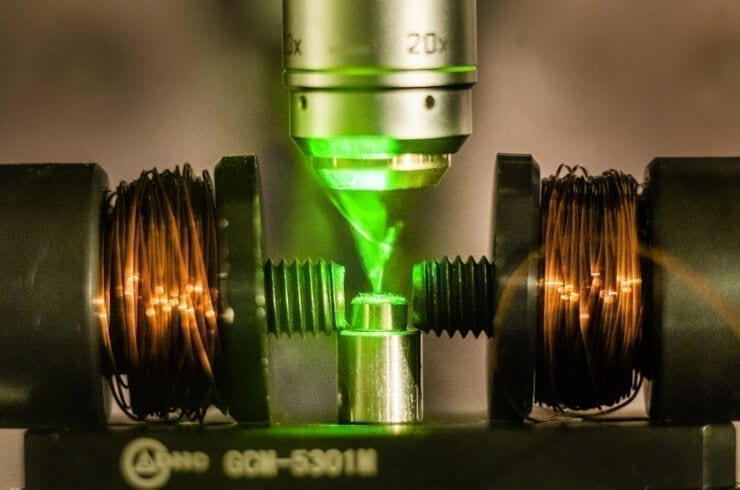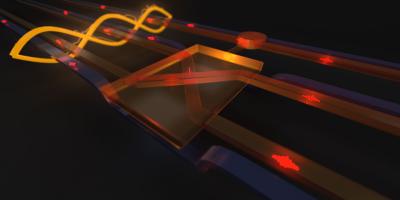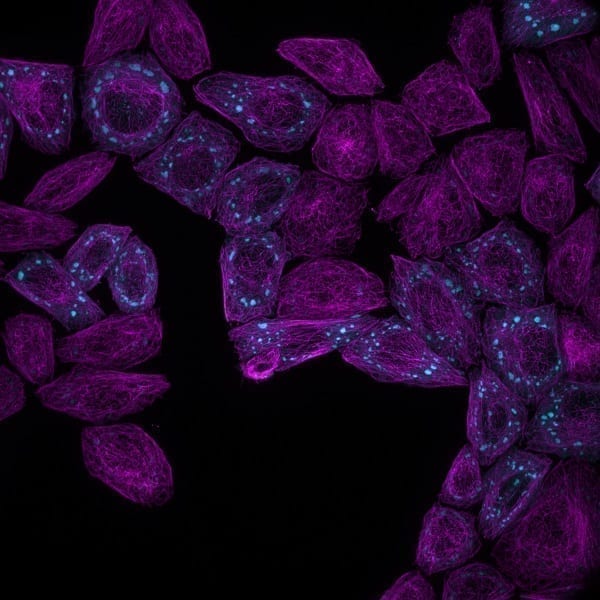
Experimental setup similar to the one the researchers have used.
Thor Balkhed
It may be possible in the future to use information technology where electron spin is used to process information in quantum computers. It has long been the goal of scientists to be able to use spin-based quantum information technology at room temperature. Researchers from Sweden, Finland and Japan have now constructed a semiconductor component in which information can be efficiently exchanged between electron spin and light – at room temperature and above.
It is well known that electrons have a negative charge, and they also have another property, namely spin. The latter may prove instrumental in the advance of information technology. To put it simply, we can imagine the electron rotating around its own axis, similar to the way in which the Earth rotates around its own axis. Spintronics – a promising candidate for future information technology – uses this quantum property of electrons to store, process and transfer information. This brings important benefits, such as higher speed and lower energy consumption than traditional electronics.
Developments in spintronics in recent decades have been based on the use of metals, and these have been highly significant for the possibility of storing large amounts of data. There would, however, be several advantages in using spintronics based on semiconductors, in the same way that semiconductors form the backbone of today’s electronics and photonics.
“One important advantage of spintronics based on semiconductors is the possibility to convert the information that is represented by the spin state and transfer it to light, and vice versa. The technology is known as opto-spintronics. It would make it possible to integrate information processing and storage based on spin with information transfer through light”, says Weimin Chen, professor at Linköping University, Sweden, who led the project.
As electronics used today operates at room temperature and above, a serious problem in the development of spintronics has been that electrons tend to switch and randomise their direction of spin when the temperature rises. This means that the information coded by the electron spin states is lost or becomes ambiguous. It is thus a necessary condition for the development of semiconductor-based spintronics that we can orient essentially all electrons to the same spin state and maintain it, in other words that they are spin polarised, at room temperature and higher temperatures. Previous research has achieved a highest electron spin polarisation of around 60% at room temperature, untenable for large-scale practical applications.
Researchers at Linköping University, Tampere University and Hokkaido University have now achieved an electron spin polarisation at room temperature greater than 90%. The spin polarisation remains at a high level even up to 110 °C. This technological advance, which is described in Nature Photonics, is based on an opto-spintronic nanostructure that the researchers have constructed from layers of different semiconductor materials (see description below the article). It contains nanoscale regions called quantum dots. Each quantum dot is around 10,000 times smaller than the thickness of a human hair. When a spin polarised electron impinges on a quantum dot, it emits light – to be more precise, it emits a single photon with a state (angular momentum) determined by the electron spin. Thus, quantum dots are considered to have a great potential as an interface to transfer information between electron spin and light, as will be necessary in spintronics, photonics and quantum computing. In the newly published study, the scientists show that it is possible to use an adjacent spin filter to control the electron spin of the quantum dots remotely, and at room temperature.
“One important advantage of spintronics based on semiconductors is the possibility to convert the information that is represented by the spin state and transfer it to light, and vice versa. The technology is known as opto-spintronics. It would make it possible to integrate information processing and storage based on spin with information transfer through light”, says Weimin Chen, professor at Linköping University, Sweden, who led the project.
As electronics used today operates at room temperature and above, a serious problem in the development of spintronics has been that electrons tend to switch and randomise their direction of spin when the temperature rises. This means that the information coded by the electron spin states is lost or becomes ambiguous. It is thus a necessary condition for the development of semiconductor-based spintronics that we can orient essentially all electrons to the same spin state and maintain it, in other words that they are spin polarised, at room temperature and higher temperatures. Previous research has achieved a highest electron spin polarisation of around 60% at room temperature, untenable for large-scale practical applications.
Researchers at Linköping University, Tampere University and Hokkaido University have now achieved an electron spin polarisation at room temperature greater than 90%. The spin polarisation remains at a high level even up to 110 °C. This technological advance, which is described in Nature Photonics, is based on an opto-spintronic nanostructure that the researchers have constructed from layers of different semiconductor materials (see description below the article). It contains nanoscale regions called quantum dots. Each quantum dot is around 10,000 times smaller than the thickness of a human hair. When a spin polarised electron impinges on a quantum dot, it emits light – to be more precise, it emits a single photon with a state (angular momentum) determined by the electron spin. Thus, quantum dots are considered to have a great potential as an interface to transfer information between electron spin and light, as will be necessary in spintronics, photonics and quantum computing. In the newly published study, the scientists show that it is possible to use an adjacent spin filter to control the electron spin of the quantum dots remotely, and at room temperature.
“One important advantage of spintronics based on semiconductors is the possibility to convert the information that is represented by the spin state and transfer it to light, and vice versa. The technology is known as opto-spintronics. It would make it possible to integrate information processing and storage based on spin with information transfer through light”, says Weimin Chen, professor at Linköping University, Sweden, who led the project.
As electronics used today operates at room temperature and above, a serious problem in the development of spintronics has been that electrons tend to switch and randomise their direction of spin when the temperature rises. This means that the information coded by the electron spin states is lost or becomes ambiguous. It is thus a necessary condition for the development of semiconductor-based spintronics that we can orient essentially all electrons to the same spin state and maintain it, in other words that they are spin polarised, at room temperature and higher temperatures. Previous research has achieved a highest electron spin polarisation of around 60% at room temperature, untenable for large-scale practical applications.
Researchers at Linköping University, Tampere University and Hokkaido University have now achieved an electron spin polarisation at room temperature greater than 90%. The spin polarisation remains at a high level even up to 110 °C. This technological advance, which is described in Nature Photonics, is based on an opto-spintronic nanostructure that the researchers have constructed from layers of different semiconductor materials (see description below the article). It contains nanoscale regions called quantum dots. Each quantum dot is around 10,000 times smaller than the thickness of a human hair. When a spin polarised electron impinges on a quantum dot, it emits light – to be more precise, it emits a single photon with a state (angular momentum) determined by the electron spin. Thus, quantum dots are considered to have a great potential as an interface to transfer information between electron spin and light, as will be necessary in spintronics, photonics and quantum computing. In the newly published study, the scientists show that it is possible to use an adjacent spin filter to control the electron spin of the quantum dots remotely, and at room temperature.
Original Article: A breakthrough that enables practical semiconductor spintronics
More from: Linköping University | Tampere University | Hokkaido University
The Latest Updates from Bing News & Google News
Go deeper with Bing News on:
Spintronics breakthrough
- A Paradigm Shift in RAM Is About to Make Computing Unstoppable
For more than two decades, the most advanced version of this technology—magnetoresistive RAM, or MRAM—has been the go-to tech for the kind of intense computing necessary in industrial, military, and ...
- Unlocking spin current secrets: A new milestone in spintronics
Using neutron scattering and voltage measurements, a group of researchers have discovered that a material's magnetic properties can predict spin current changes with temperature. The finding is a ...
- Spintronics Breakthrough: Unlocking the Power of Radial Vortices
A team at HZB has investigated a new, simple method at BESSY II that can be used to create stable radial magnetic vortices in magnetic thin films. In some materials, spins form complex magnetic struct ...
- MIT Unlocks the Power of 2D Magnets for Future Computing
MIT scientists have tackled key obstacles to bringing 2D magnetic materials into practical use, setting the stage for the next generation of energy-efficient computers. Globally, computation is ...
- Researchers develop energy-efficient probabilistic computer by combining CMOS with stochastic nanomagnet
Researchers at Tohoku University and the University of California, Santa Barbara, have unveiled a probabilistic computer prototype. Manufacturable with a near-future technology, the prototype combines ...
Go deeper with Google Headlines on:
Spintronics breakthrough
[google_news title=”” keyword=”spintronics breakthrough” num_posts=”5″ blurb_length=”0″ show_thumb=”left”]
Go deeper with Bing News on:
Spintronics
- NVE Schedules Conference Call on Fourth-Quarter and Fiscal Year Results
EDEN PRAIRIE, Minn., April 24, 2024 (GLOBE NEWSWIRE) -- (Nasdaq: NVEC) announced that it plans to release its financial results for the quarter and fiscal year ended March 31, 2024 on Wednesday, May ...
- A Paradigm Shift in RAM Is About to Make Computing Unstoppable
For more than two decades, the most advanced version of this technology—magnetoresistive RAM, or MRAM—has been the go-to tech for the kind of intense computing necessary in industrial, military, and ...
- Here’s Everything You Need To Know About Spintronics
Spintronics, also known as spin electronics, is a rapidly developing field that explores the potential of utilising the spin of electrons in solid-state devices. Spin is one of the three ...
- Unlocking spin current secrets: A new milestone in spintronics
Using neutron scattering and voltage measurements, a group of researchers have discovered that a material's magnetic properties can predict spin current changes with temperature. The finding is a ...
- Spintronics research shows material's magnetic properties can predict how a spin current changes with temperature
Spintronics is a field garnering immense attention for its range of potential advantages for conventional electronics. These include reducing power consumption, high-speed operation, non-volatility, ...
Go deeper with Google Headlines on:
Spintronics
[google_news title=”” keyword=”spintronics” num_posts=”5″ blurb_length=”0″ show_thumb=”left”]










